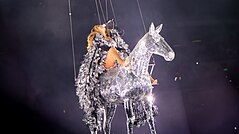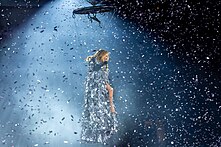Renaissance World Tour
[25] A pre-sale on February 3, which was organized by Live Nation, saw over 3 million people trying to get tickets for dates in the UK, France, Sweden and Poland, which caused Ticketmaster to crash.
[31][29][32] Beyoncé's shows in Paris and Marseille sold out within minutes, with hundreds of thousands of fans trying to buy tickets and the Stade de France site crashing.
Financial Times reported that economists at Danske Bank believe that Beyoncé's decision to start her world tour in Stockholm led to a surge in local hotel prices that resulted in inflation in Sweden exceeding expectations, further calling it "astonishing for a single event".
[40] The design process took eighteen months and was held in charge by Es Devlin Studio and Stufish Entertainment Architects, along with Beyoncé and her creative team, Parkwood.
[50][51] For the June 18 show in Amsterdam, Beyoncé celebrated the Juneteenth holiday by wearing exclusively Black designers, including Feben, Maximilian Davis for Ferragamo, Olivier Rousteing for Balmain, Ib Kamara for Off-White, LaQuan Smith, and her own Ivy Park collection.
[55] Pink clouds are shown on the screen as an image of a glitching signboard rises, forming a picture of Beyoncé in a pose similar to Giorgione's Sleeping Venus.
[56] A visual interlude marks the next act as Renaissance,[57] showing a maximalist montage of intergalactic travel and robotic machines reminiscent of Fritz Lang's 1927 sci-fi film Metropolis.
[60][61] A massive, inflatable disco horse prop is wheeled out of the dome and onto the stage in preparation for "Break My Soul".,[62] where Beyoncé and the dancers make their way around the perimeter of the B-Stage.
[57] This section begins with "Formation", which is followed by "Diva", making reference to rapper Lil Uzi Vert's viral dance on TikTok, and "Run the World (Girls)" on the ramp of the B-stage.
[58] Following an interlude opening the church-themed Anointed section,[57] Beyoncé emerges from the dome in all-white robe that is struck by ultraviolet light to reveal a colorful pattern evocative of stained glass, which is then removed for a performance of "Church Girl", "Get Me Bodied" and "Before I Let Go".
After the performance, as she exits the stage, her dancers arrive to vogue in a ballroom battle to an extended outro of the song, featuring pre-recorded commentary from Kevin Jz Prodigy, with various members of the troupe taking turns displaying dance moves as the others cheer them on.
For each date (with some exceptions), Kevin would announce particular categories, each notably performed by a given member of Beyoncé's dance crew, namely Carlos Irizarry (Old Way), Aliya Janell (Shake That Ass), Aahkilah Cornelius (Sex Siren), Darius Hickman (Soft and Cunt Performance), Amari Marshall (Body), Jonte (Face + Structure), Nerita McFarlane (Runway), and Honey Balenciaga (Vogue Fem).
[58][77] Beyoncé returns seated atop a shiny life-size horse mannequin wearing a sparkly silver dress to perform "Summer Renaissance" as the Encore.
[58] She then thanks the crowd and exits the stage as the screen is left with a photo of her mother Tina and her uncle Johnny, a major inspiration behind the Black, queer sounds of the Renaissance album.
[108] Neil McCormick, chief music critic for The Telegraph, also gave the show 5 out of 5 stars, remarking that "We've seen plenty of multimedia rock extravaganzas and state of the art pop spectaculars, but this was something else: a sci-fi stadium-scale superclub, the greatest disco in the known universe" while also praising Beyoncé's "absurdly powerhouse singing".
[109] Kitty Empire declared the tour a "masterclass", describing it as a "banging, progressive, LGBTQ+-embracing, Afrofuturist extravaganza" that encourages concertgoers to feel joyous and liberated.
[55] In a review for the Evening Standard, Emma Loffhagen wrote that the tour pushes "the boundaries of 21st-century performance technology", with innovations including a UV-sensitive color-changing gown, a flying sequined horse and robotic arms.
[111] Describing it as "one of the most incredible live performances in recent memory", Refinery29's Alexis Jackson praised the tour's "visually stunning" and "elaborate" stage design.
[112] Following the tour's first North American stop, in Toronto, The New York Times labeled the show a "Critic's Pick", with Lindsay Zoladz highlighting "Beyoncé's endurance as a world-class performer", noting that she "is the rare major pop star who prizes live vocal prowess".
"[114] Vogue writer André-Naquian Wheeler stated that Beyoncé "has upended the typical stadium show model and turned it into an ever-changing format", taking it "to unprecedented heights".
Wheeler also analyzes the look of the show as an expression of "Renaissance's ballroom-inspired sonic and visual aesthetic", a way for the singer to "use fashion as a medium to silently signal a connection and appreciation towards a culture or community".
[138][139] Morgan Stanley warned clients of a similar rise in inflation in the US, with global chief economist Seth Carpenter saying: "The Beyoncé effect should keep us from getting too complacent.
Brett House, economist at Columbia Business School, said that the tour has helped create a "gentle cool-down" of economic activity in the US during the summer, instead of the usual abrupt stop.
[125] Professor Tom Smith of Emory University's Goizueta Business School used the Renaissance World Tour as a case study in his lectures about events that have a significant impact on markets.
[147][148] In Santa Clara, VTA, BART and Caltrain all announced that they were increasing the number of trains and extending service hours for Beyoncé's shows in the city.
[157][158] Social commerce marketplaces Depop and Poshmark reported a rise in demand for silver clothing and a 500% increase in sales for items with "Renaissance" in the description or title.
[154][159] British supermodel Naomi Campbell designed a collection with metallic clothing inspired by the Renaissance World Tour, saying that it is "no longer a concert" but a movement.
[129] British luxury retailer Flannels, which Beyoncé partnered with to open a merchandise store in London, said that an increase in demand "was immediate" and that engagement continued to grow "with incredible momentum", noting thousands of viral social media posts, long queues and sold-out products.
Throughout the tour, Beyoncé's BeyGOOD Foundation provided 1,000 small business owners from marginalized communities with grant opportunities, celebration luncheons, and resources to support entrepreneurship.
All profits from the sale of this collection were donated to the ABOUT LOVE Scholarship Program, a partnership between Tiffany & Co., BeyGOOD, and the Shawn Carter Foundation, benefiting students in the arts and creative fields at historically black colleges and universities.








